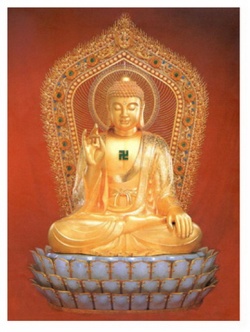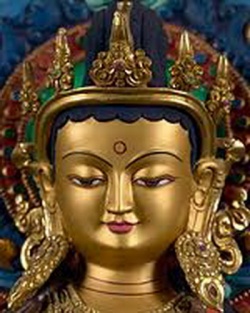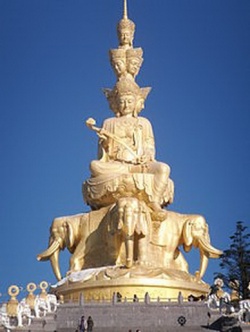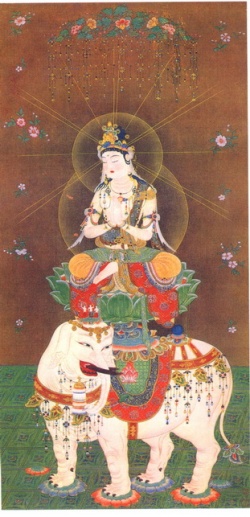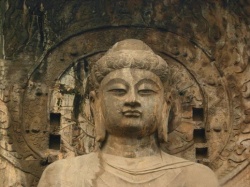Difference between revisions of "Summary of the Yogācārabhūmi-śāstra"
| (10 intermediate revisions by 4 users not shown) | |||
| Line 1: | Line 1: | ||
[[File:Fj4.jpg|thumb|250px|]] | [[File:Fj4.jpg|thumb|250px|]] | ||
<poem> | <poem> | ||
| − | 瑜伽師地論 | + | [[瑜伽師地論]] |
| + | [[File:0f7ce.jpg|thumb|250px|]] | ||
| + | [[File:1.125891.jpg|thumb|250px|]] | ||
| + | [[Dan Lusthaus]] and {{Wiki|Charles Muller}} | ||
| + | [py] Yu2qie2 shi1di4 lun4 [wg] Yü-ch'ieh shih-ti [[lun]] ([[ko]]) [[Yuga]] saji non [ja] [[Yuga]] [[shiji]] ron ||| The [[Yuqie]] [[shidi]] [[lun]]; commonly abbreviated as [[Yuqielun]] [[瑜伽論]]. The [[Yogācāra-bhūmi-śāstra]]. The "{{Wiki|Discourse}} on the [[Stages of Concentration Practice]]." The definitive text of the [[Yogācāra]] [[瑜伽行派]] school of [[Buddhism]]. One hundred fascicles, composed in [[India]] between 300 and 350 CE; translated into {{Wiki|Chinese}} by [[Xuanzang]] [[玄奘]] from July 3, 646 to June 11, 648. In [[East]] {{Wiki|Asia}} the putative author is [[thought]] to be [[Maitreya]] [[彌勒]], but [[Tibetan tradition]] considers it to have been composed by [[Asaṅga]] [[無著]]. | ||
| − | + | In the process of explaining the [[spiritual]] states, practices and {{Wiki|fruits}} incurred in the course of the seventeen stages leading to [[Buddhahood]], the text delves deeply into discussions of fundamental [[Yogācāra]] [[Wikipedia:concept|concepts]] such as the [[ālaya-vijñāna]] [[阿賴耶識]], [[three natures]] ([[trisvabhāva]]) [[三自性]] and [[three non-natures]] ([[triniḥsvabhāva]]) [[三無自性]], [[seeds]] ([[bījā]]) [[種子]], [[perfumation]] ([[vāsanā]]) [[熏習]], the [[two hindrances]] ([[āvaraṇa]]) [[二障]] and [[mind only]] ([[vijñapti-mātra]], [[vijñāna-mātra]]) [[唯識]]. The text has five major divisions: the first [[division]], which comprises about half the treatise is called the "[[main stages division]]" ([[bahubhūmika]]) [[本地分]] and contains seventeen [[sections]], each describing one of the successive seventeen stages, or [[bhūmis]]. These are (as found in [[Xuanzang's]] 100 fascicles): | |
| − | [ | + | [Initial {{Wiki|Phenomenology}}] |
| − | |||
| − | |||
| − | |||
| − | |||
[[File:Samantabhadra140.jpg|thumb|250px|]] | [[File:Samantabhadra140.jpg|thumb|250px|]] | ||
| − | (1) The stage of the five consciousnesses associated with the body - pañca-vijñāna-kāya-saṃprayukta- | + | (1) The stage of the [[five consciousnesses]] associated with the [[body]] - [[pañca-vijñāna-kāya-saṃprayukta-bhūmi]] [[五識身相應地]]. (First fascicle) |
| − | (2) The stage of mental intent - mano- | + | (2) The [[stage of mental intent]] - [[mano-bhūmi]] [[意地]]. (fascicles 1-3) |
| − | [Dhyāna Levels] | + | [[Dhyāna]] Levels] |
| − | (3) The stage of (initial meditative) investigation and analysis - savitarkā-savicarā-bhūmi) 有尋有伺. (fascicles 4-10) | + | (3) The stage of (initial [[meditative]]) [[investigation]] and {{Wiki|analysis}} - [[savitarkā-savicarā-bhūmi]]) [[有尋有伺]]. (fascicles 4-10) |
| − | Note: Xuanzang includes the next two bhūmis within the title of this bhūmi) | + | Note: [[Xuanzang]] includes the next two [[bhūmis]] within the title of this [[bhūmi]]) |
| − | (4) The stage of analysis without investigation - avitarka- savicarā-bhūmi 無尋唯伺地. | + | (4) The [[stage of analysis without investigation]] - [[avitarka- savicarā-bhūmi]] [[無尋唯伺地]]. |
| − | (5) The stage of neither investigation nor analysis - avitarka-avicārā-bhūmi 無尋無伺地. | + | (5) The [[stage of neither investigation nor analysis]] - [[avitarka-avicārā-bhūmi]] [[無尋無伺地]]. |
| − | (6) The stage of samāhita (thought "collected" in meditation) - samāhita-bhūmi 三摩呬多地. (fascicles 11-13) | + | (6) The [[stage of samāhita]] ([[thought]] "collected" in [[meditation]]) - [[samāhita-bhūmi]] [[三摩呬多地]]. (fascicles 11-13) |
| − | (7) The stage of non-samāhita - asamāhita-bhūmi 非三摩呬多地. (fascicle 13) | + | (7) The [[stage of non-samāhita]] - [[asamāhita-bhūmi]] [[非三摩呬多地]]. (fascicle 13) |
| − | (8) The stage with mind - sacittaka-bhūmi 心地. (fascicle 13) | + | (8) The [[stage with mind]] - [[sacittaka-bhūmi]] [[心地]]. (fascicle 13) |
| − | (9) The stage without mind - acittaka-bhūmi 無心地. (fascicle 13) | + | (9) The [[stage without mind]] - [[acittaka-bhūmi]] [[無心地]]. (fascicle 13) |
| − | [Hearing, Thinking, Cultivation] | + | [[Hearing]], [[Thinking]], [[Cultivation]]) |
| − | (10) The stage of actualizing what one has heard (i.e., the teachings) - śrutamayī-bhūmī 聞所成地. (fascicles 13-15) | + | (10) The stage of actualizing what one has [[heard]] (i.e., the teachings) - [[śrutamayī-bhūmī]] [[聞所成地]]. (fascicles 13-15) |
[[File:&cvt=jpeg.jpg|thumb|250px|]] | [[File:&cvt=jpeg.jpg|thumb|250px|]] | ||
| − | This deals with the five fields of knowledge, pañca- | + | This deals with the five fields of [[knowledge]], [[pañca-vidyā]] [[五明]]: |
| − | 1. 'Inner knowledge,' adhyātma- | + | 1. 'Inner [[knowledge]],' [[adhyātma-vidyā]] [[內明]] (i.e., the [[truths]] of [[Buddhism]]); |
| − | 2. medicine, cikitsā-vidyā 藥明; | + | 2. [[medicine]], [[cikitsā-vidyā]] [[藥明]]; |
| − | 3. logic, hetu- | + | 3. [[logic]], [[hetu-vidyā]] [[因明]]; |
| − | 4. grammar and language, śabda-vidyā 聲明; and | + | 4. [[grammar]] and [[language]], śabda-vidyā 聲明; and |
| − | 5. the arts, śilpakarma-vidyā 工巧. | + | 5. the [[arts]], [[śilpakarma-vidyā]] [[工巧]]. |
| − | (11) The stage of actualizing what one has thought (about the teachings) - cintāmayī-bhūmi 思所成地. (fascicles 16-19) | + | (11) The stage of actualizing what one has [[thought]] (about the teachings) - [[cintāmayī-bhūmi]] [[思所成地]]. (fascicles 16-19) |
| − | (12) The state of actualizing what one has practiced - bhāvanā-bhūmi 修所成地. (fascicle 20) | + | (12) The [[state]] of actualizing what one has practiced - [[bhāvanā-bhūmi]] [[修所成地]]. (fascicle 20) |
| − | [Śrāvaka-bhūmi] | + | [[Śrāvaka-bhūmi]] |
| − | (13) The stage of the Śrāvaka - śrāvaka-bhūmi 聲聞地. (fascicles 21-34, divided as follows) | + | (13) The stage of the [[Śrāvaka]] - [[śrāvaka-bhūmi]] [[聲聞地]]. (fascicles 21-34, divided as follows) |
| − | (13a) The types and natures of the first Yoga Capacity 初瑜伽處種性地 (fascicle 21) | + | (13a) The types and natures of the first [[Yoga]] Capacity [[初瑜伽處種性地]] (fascicle 21) |
| − | (13b) Interest to Enter the first Yoga Capacity 初瑜伽處趣入地 (fascicle 21) | + | (13b) [[Interest]] to Enter the first [[Yoga]] Capacity [[初瑜伽處趣入地]] (fascicle 21) |
| − | (13c) Going beyond the first Yoga Capacity 初瑜伽處出離地 (fascicles 22-25) | + | (13c) Going [[beyond]] the first [[Yoga]] Capacity [[初瑜伽處出離地]] (fascicles 22-25) |
| − | (13d) The second Yoga Capacity 第二瑜伽處 (fascicles 26-29) | + | (13d) The second [[Yoga]] Capacity [[第二瑜伽處]] (fascicles 26-29) |
| − | (13e) The third Yoga Capacity 第三瑜伽處 (fascicles 30-32) | + | (13e) The third [[Yoga]] Capacity [[第三瑜伽處]] (fascicles 30-32) |
| − | (13f) The fourth Yoga Capcacity 第四瑜伽處 (fascicles 33-34) | + | (13f) The fourth [[Yoga]] Capcacity [[第四瑜伽處]] (fascicles 33-34) |
[[File:0107.jpg|thumb|250px|]] | [[File:0107.jpg|thumb|250px|]] | ||
| − | [Pratyekabuddha-bhūmi] | + | [[Pratyekabuddha-bhūmi]] |
| − | (14) The stage of the Pratyekabuddha - pratyekabuddha-bhūmi 獨覺地. (fascicle 35 | + | (14) The stage of the [[Pratyekabuddha]] - [[pratyekabuddha-bhūmi]] [[獨覺地]]. (fascicle 35 |
| − | [Bodhisattva-bhūmi] | + | [[Bodhisattva-bhūmi]] |
| − | (15) The stage of Bodhisattva - bodhisattva- | + | (15) The stage of [[Bodhisattva]] - [[bodhisattva-bhūmi]] [[菩薩地]]. (fascicles 35-50) |
Its subdivisions are: | Its subdivisions are: | ||
| − | [1st Bodhisattva Section] | + | [1st [[Bodhisattva]] Section] |
| − | (15a) First taking hold of Yogic Capacities (āyatana)初持瑜伽處 (fascicles 35-46): | + | (15a) First taking hold of [[Yogic]] Capacities ([[āyatana]])[[初持瑜伽處]] (fascicles 35-46): |
| − | (15a.1) Chapter on Their Types and Natures - gotra 種性品 (fascicle35) | + | (15a.1) [[Chapter]] on Their Types and Natures - [[gotra]] [[種性品]] (fascicle35) |
| − | (15a.2) Chapter on (arousing the) Mind (aspiring to Bodhi) – prathama-cittopāda 心品 (fascicle 35) | + | (15a.2) [[Chapter]] on (arousing the) [[Mind]] (aspiring to [[Bodhi]]) – [[prathama-cittopāda]] [[心品]] (fascicle 35) |
| − | (15a.3) Chapter on Benefiting Self and Others - svaparārtha 自他利品 (fascicles 35-36) | + | (15a.3) [[Chapter]] on Benefiting [[Self]] and Others - [[svaparārtha]] [[自他利品]] (fascicles 35-36) |
| − | (15a.4) Chapter on the Realities Referred to (by these capacities) - tattvārtha 實真義品 (fascicle 36) | + | (15a.4) [[Chapter]] on the [[Realities]] Referred to (by these capacities) - [[tattvārtha]] [[實真義品]] (fascicle 36) |
| − | (15a.5) Chapter on Awesome Power - prabhāva 威力品 (fascicle 37) | + | (15a.5) [[Chapter]] on Awesome [[Power]] - [[prabhāva]] 威力品 (fascicle 37) |
| − | (15a.6) Chapter on Bodhi 菩提品 (fascicle 38) | + | (15a.6) [[Chapter]] on [[Bodhi]] [[菩提品]] (fascicle 38) |
| − | (15a.7) Chapter on the Power [affecting] types of Births - balagotra 力種生 (fascicle 38) | + | (15a.7) [[Chapter]] on the [[Power]] [affecting] types of [[Births]] - [[balagotra]] [[力種生]] (fascicle 38) |
[[File:Samantabhadra145.jpg|thumb|250px|]] | [[File:Samantabhadra145.jpg|thumb|250px|]] | ||
| − | [Six Pāramitās] | + | [Six [[Pāramitās]] |
[[File:Prahasti-03.jpg|thumb|250px|]] | [[File:Prahasti-03.jpg|thumb|250px|]] | ||
| − | (15a.8) Chapter on Giving (dāna) 施品 (fascicle 39) | + | (15a.8) [[Chapter]] on Giving ([[dāna]]) [[施品]] (fascicle 39) |
| − | (15.a.9) Chapter on Behavioral Discipline (śīla) 戒品 (fascicles 40-42) | + | (15.a.9) [[Chapter]] on {{Wiki|Behavioral}} [[Discipline]] ([[śīla]]) 戒品 (fascicles 40-42) |
| − | (15a.10) Chapter on Forebearance (kṣānti) 忍品 (fascicle 42) | + | (15a.10) [[Chapter]] on Forebearance ([[kṣānti]]) [[忍品]] (fascicle 42) |
| − | (15a.11) Chapter on Vigor (vīrya) 精進品 (fascicle 42) | + | (15a.11) [[Chapter]] on [[Vigor]] ([[vīrya]]) [[精進品]] (fascicle 42) |
| − | (15a.12) Chapter on Quieting Mental Anxiety 靜慮品 | + | (15a.12) [[Chapter]] on Quieting [[Mental]] [[Anxiety]] [[靜慮品]] |
| − | (15a.13) Chapter on Insight (prajñā) 慧 (fascicle 43) | + | (15a.13) [[Chapter]] on [[Insight]] ([[prajñā]]) [[慧]] (fascicle 43) |
| − | [1st Bodhisattva Section Miscellania] | + | [1st [[Bodhisattva]] Section Miscellania] |
| − | (15a.14) Chapter on Select Topics 攝事品(fascicle 43) | + | (15a.14) [[Chapter]] on Select Topics [[攝事品]](fascicle 43) |
| − | (15a.15) Chapter on Giving Unlimited Offerings to those near and far 供養親近無量品 (fascicle 44) | + | (15a.15) [[Chapter]] on Giving [[Unlimited]] [[Offerings]] to those near and far [[供養親近無量品]] (fascicle 44) |
| − | (15a.16) Chapter on Divisions of Bodhi 菩提分品 (fascicles 44-46) | + | (15a.16) [[Chapter]] on Divisions of [[Bodhi]] [[菩提分品]] (fascicles 44-46) |
| − | Bodhisattva follows good or bad inherent abilities and good or bad cognitive bases | + | [[Bodhisattva]] follows good or bad [[inherent]] {{Wiki|abilities}} and good or bad [[cognitive]] bases |
| − | (15a.17) Chapter on the Qualities (guṇāḥ) of a Bodhisattva 菩薩功德品 (fascicle 46) | + | (15a.17) [[Chapter]] on the Qualities (guṇāḥ) of a [[Bodhisattva]] [[菩薩功德品]] (fascicle 46) |
| − | Ten Basic Qualities (in the pursuit of Unexcelled Complete Awakening): | + | Ten Basic Qualities (in the pursuit of Unexcelled Complete [[Awakening]]): |
| − | 1. Inherent Capacity - gotra-stha | + | 1. [[Inherent]] Capacity - [[gotra-stha]] [[種性]](= [[姓]]) |
2. Entry - avatīrṇa入 | 2. Entry - avatīrṇa入 | ||
| − | 3. Intention not yet Purified - aśuddhāśaya 未凈意 | + | 3. {{Wiki|Intention}} not yet [[Purified]] - [[aśuddhāśaya]] 未凈意 |
| − | 4. Intention Purified - śuddhāśaya 凈意樂 | + | 4. {{Wiki|Intention}} [[Purified]] - śuddhāśaya [[凈意樂]] |
5. Not yet Matured - aparipakva 未成熟 | 5. Not yet Matured - aparipakva 未成熟 | ||
6. Already Matured - paripakva 已成熟 | 6. Already Matured - paripakva 已成熟 | ||
| − | 7. Undetermined (i.e., still capable of backsliding) - āniyati-patita 未墮決定 | + | 7. [[Undetermined]] (i.e., still capable of backsliding) - [[āniyati-patita]] [[未墮決定]] |
8. Determined (i.e., incapable of backsliding) - niyati-patita 已墮決定 | 8. Determined (i.e., incapable of backsliding) - niyati-patita 已墮決定 | ||
| − | 9. Bound to One (more) birth - eka-jāti-pratibandha 一生所繫 | + | 9. [[Bound]] to One (more) [[birth]] - [[eka-jāti-pratibandha]] [[一生所繫]] |
| − | 10. Final Body - carama-bhavika 最後身 | + | 10. Final [[Body]] - [[carama-bhavika]] [[最後身]] |
[[File:0123.jpg|thumb|250px|]] | [[File:0123.jpg|thumb|250px|]] | ||
| − | This chapter offers multiple lists of practices for the benefit of other sentient beings, such as: | + | This [[chapter]] offers multiple lists of practices for the [[benefit]] of other [[sentient beings]], such as: |
| − | 1. When the Bodhisattva gives rise to the Thought (cittotpāda 發心) vowing to attain Great Bodhi (bodhicitta 大菩提), he benefits all sentient beings by giving rise to an Equalizing Mind. | + | 1. When the [[Bodhisattva]] gives rise to the [[Thought]] ([[cittotpāda]] [[發心]]) vowing to attain Great [[Bodhi]] ([[bodhicitta]] [[大菩提]]), he benefits all [[sentient beings]] by giving rise to an Equalizing [[Mind]]. |
| − | 2. Bodhisattva's mind sympathizes (with the suffering) of all sentient beings equally. | + | 2. [[Bodhisattva's]] [[mind]] sympathizes (with the [[suffering]]) of all [[sentient beings]] equally. |
| − | 3. Bodhisattva's mind loves all sentient beings as if each were his only son. | + | 3. [[Bodhisattva's]] [[mind]] loves all [[sentient beings]] as if each were his only son. |
| − | 4. Knowing the dispositions of one sentient being, he knows all, helping all. | + | 4. [[Knowing]] the dispositions of one [[sentient being]], he [[knows]] all, helping all. |
| − | 5. Benefitting one sentient being, he benefits all equally. | + | 5. Benefitting one [[sentient being]], he benefits all equally. |
| − | There are ten types of āyatanas (meditative capacities): | + | There are ten types of [[āyatanas]] ([[meditative]] capacities): |
| − | 1. Capacity to fully detach from bad saṃskāras 遠離惡行處 | + | 1. Capacity to fully detach from bad [[saṃskāras]] [[遠離惡行處]] |
| − | 2. Capacity to fully detach from desires 遠離諸欲處 | + | 2. Capacity to fully detach from [[desires]] [[遠離諸欲處]] |
| − | 3. Capacity to become fully engrossed without transgression | + | 3. Capacity to become fully engrossed without {{Wiki|transgression}} [[專精無犯]],[[犯已能出處]] |
| − | 4. Capacity to secretly guard all the sensory faculties 密護一切諸根門處 | + | 4. Capacity to secretly guard all the sensory [[faculties]] 密護一切諸根門處 |
| − | 5. Capacity to abide in correct knowledge 正知住處 | + | 5. Capacity to abide in correct [[knowledge]] [[正知住處]] |
| − | 6. Capacity to detach from troubles and anxieties 離憒鬧處 | + | 6. Capacity to detach from troubles and anxieties [[離憒鬧處]] |
| − | 7. Capacity to fully detach, detaching from all bad meditative reflections | + | 7. Capacity to fully detach, detaching from all bad [[meditative]] reflections [[於遠離處]],[[遠離惡尋思處]] |
| − | 8. Capacity to fully detach from obstacles 遠離障處 | + | 8. Capacity to fully detach from {{Wiki|obstacles}} [[遠離障處]] |
| − | 9. Capacity to fully detach from being wrapped up in kleśa (mental disturbances) 遠離一切煩惱纏處 | + | 9. Capacity to fully detach from [[being]] wrapped up in [[kleśa]] ([[mental]] {{Wiki|disturbances}}) [[遠離一切煩惱纏處]] |
| − | 10. Capacity to fully detach from all kleśas and the crude barriers (dauṣṭulya) | + | 10. Capacity to fully detach from all [[kleśas]] and the crude barriers ([[dauṣṭulya]]) |
| − | 遠離一切諸煩惱品諸麤重處 | + | [[遠離一切諸煩惱品諸麤重處]] |
[[File:Samantabhadra-px11.jpg|thumb|250px|]] | [[File:Samantabhadra-px11.jpg|thumb|250px|]] | ||
| − | In this chapter Asaṅga also offers a numerical list of 'truths': | + | In this [[chapter]] [[Asaṅga]] also offers a numerical list of '[[truths]]': |
| − | 1. One truth, without a second. | + | 1. One [[truth]], without a second. |
| − | 2. Two Truths, vyavahāra and paramārtha | + | 2. [[Two Truths]], [[vyavahāra]] and [[paramārtha]] |
| − | 3. Three Truths: characteristic, language and function | + | 3. [[Three Truths]]: [[characteristic]], [[language]] and [[function]] [[相諦]],[[語諦]],[[用諦]] |
| − | 4. Four Noble Truths | + | 4. [[Four Noble Truths]] |
| − | 5. Five Truths: truth of cause, truth of effect, truth of wisdom, truth of a sense-object, best truth (hetu | + | 5. [[Five Truths]]: [[truth of cause]], [[truth of effect]], [[truth of wisdom]], [[truth of a sense-object]], [[best truth]] ([[hetu]] [[因諦]],[[phala]] [[果諦]],[[prajñā]] [[智諦]],[[viṣaya]] [[境諦]],[[勝諦]]); Etc., (up to Ten [[truths]]). |
| − | [2nd Bodhisattva Section] | + | [2nd [[Bodhisattva]] Section] |
| − | (15b) Second, Taking Hold of Yogic Capacities by Following the Dharma (fascicles 47-48) 第二持隨法瑜伽處 | + | (15b) Second, Taking Hold of [[Yogic]] Capacities by Following the [[Dharma]] (fascicles 47-48) [[第二持隨法瑜伽處]] |
| − | (15b.1) Chapter on Characteristics of a Bodhisattva - bodhisattva- | + | (15b.1) [[Chapter]] on {{Wiki|Characteristics}} of a [[Bodhisattva]] - [[bodhisattva-lakṣaṇa]] [[菩薩相品]](fascicle 47) |
| − | (15b.2) Chapter on Divisions (of Bodhisattvas) 分品 (fascicle 47) | + | (15b.2) [[Chapter]] on Divisions (of [[Bodhisattvas]]) [[分品]] (fascicle 47) |
| − | Divides Bodhisattvas into laity and clerics, both of whom can realize Unexcelled Complete Awakening (anuttara-samyak-saṃbodhi). | + | Divides [[Bodhisattvas]] into laity and {{Wiki|clerics}}, both of whom can realize Unexcelled Complete [[Awakening]] ([[anuttara-samyak-saṃbodhi]]). |
| − | (15b.3) Chapter on Increasing the Intent (for Buddha-fruit) 增上意樂 *adhipati-adhyāśaya (fascicle 47) | + | (15b.3) [[Chapter]] on {{Wiki|Increasing}} the Intent (for [[Buddha]]-[[fruit]]) [[增上意樂]] *[[adhipati-adhyāśaya]] (fascicle 47) |
| − | Bodhisattva purifies his intent through understanding and improving his karmic condition. | + | [[Bodhisattva]] purifies his intent through [[understanding]] and improving his [[karmic]] [[condition]]. |
[[File:Fo5.jpg|thumb|250px|]] | [[File:Fo5.jpg|thumb|250px|]] | ||
| − | (15b.4) Chapter on (types of meditative) Abodes | + | (15b.4) [[Chapter]] on (types of [[meditative]]) [[Abodes]] [[住品]] [[avasthāna]] (fascicles 47-48) |
| − | Detailed discussion of the Twelve types of Meditative Abodes (plus an additional Abode only for Buddhas): | + | Detailed [[discussion]] of the Twelve types of [[Meditative]] [[Abodes]] (plus an additional Abode only for [[Buddhas]]): |
| − | 1. Abode of Inherent Capacities in one's present life - gotra-stha-avasthāna 種性(= 姓)住 | + | 1. Abode of [[Inherent]] Capacities in one's {{Wiki|present}} [[life]] - [[gotra-stha-avasthāna]] [[種性]](= [[姓)住]] |
| − | 2. Abode of Practicing with Confident Resolve - | + | 2. Abode of Practicing with [[Confident Resolve]] - [[adhimokṣa]] [[勝解行住]] |
| − | 3. Joyous Abode 極歡喜住 | + | 3. [[Joyous]] [[Abode]] [[極歡喜住]] |
| − | [Śīla Samādhi Prajñā] | + | [[Śīla]] [[Samādhi]] [[Prajñā]] |
| − | 4. Abode of Increasing Behavioral Discipline - adhi-śīla 增上戒住 | + | 4. Abode of {{Wiki|Increasing}} {{Wiki|Behavioral}} [[Discipline]] - [[adhi-śīla]] [[增上戒住]] |
| − | 5. Abode of Increasing Mind (=samādhi) - adhi-citta 增上心住 | + | 5. Abode of {{Wiki|Increasing}} [[Mind]] (=[[samādhi]]) - [[adhi-citta]] [[增上心住]] |
| − | (6-8. Abodes of Increasing Wisdom - adhi-prajñā 增上慧住) | + | (6-8. [[Abodes]] of {{Wiki|Increasing}} [[Wisdom]] - [[adhi-prajñā]] [[增上慧住]]) |
| − | 6. Abode of Increasing Wisdom associated with Awakening 覺分相應增上慧住 (practicing the 37 Bodhipakṣya dharmāḥ) | + | 6. Abode of {{Wiki|Increasing}} [[Wisdom]] associated with [[Awakening]] [[覺分相應增上慧住]] (practicing the 37 [[Bodhipakṣya dharmāḥ]]) |
| − | 7. Abode of Increasing Wisdom associated with the truths 諸諦相應增上慧住 (Realization of the Four Noble Truths) | + | 7. Abode of {{Wiki|Increasing}} [[Wisdom]] associated with the [[truths]] [[諸諦相應增上慧住]] ([[Realization]] of the [[Four Noble Truths]]) |
| − | 8. Abode of Increasing Wisdom associated with bringing future lives in the samsaric flow of conditioned arising to an end 緣起流轉止息相應增上慧住 | + | 8. Abode of {{Wiki|Increasing}} [[Wisdom]] associated with bringing {{Wiki|future}} [[lives]] in the [[samsaric]] flow of [[conditioned arising]] to an end [[緣起流轉止息相應增上慧住]] |
| − | [Abodes without Characterisitcs] | + | ([[Abodes]] without Characterisitcs] |
[[File:PRII large.jpg|thumb|250px|]] | [[File:PRII large.jpg|thumb|250px|]] | ||
| − | 9. Abode Without Characteristics, [achieved through] Preliminary Practice (prayoga) and Diligent Implementation (abhisaṃskāra), [so as to] advance on the Way without interruption or impairment, 有加行有功用無間缺道運轉無相住 | + | 9. Abode Without {{Wiki|Characteristics}}, [achieved through] Preliminary Practice ([[prayoga]]) and Diligent Implementation ([[abhisaṃskāra]]), [so as to] advance on the Way without interruption or {{Wiki|impairment}}, [[有加行有功用無間缺道運轉無相住]] |
| − | Knowing "the Suchness of all dharmas with nondiscriminative wisdom" 於一切法真如無分別慧 | + | [[Knowing]] "the [[Suchness]] of all [[dharmas]] with nondiscriminative [[wisdom]]" [[於一切法真如無分別慧]] |
| − | 10. Abode Without Characteristics, [achieved instantaneously] without Preliminary Practice or Diligent Implementation, [so as to] advance on the Way without interruption or impairment 無加行無功用無間缺道運轉無相住 | + | 10. Abode Without {{Wiki|Characteristics}}, [achieved instantaneously] without Preliminary Practice or Diligent Implementation, [so as to] advance on the Way without interruption or {{Wiki|impairment}} [[無加行無功用無間缺道運轉無相住]] |
| − | The Bodhisattva, "after much practice in the previous Abodes, spontaneously advances without interruption, without impairment" | + | The [[Bodhisattva]], "after much [[practice]] in the previous [[Abodes]], spontaneously advances without interruption, without {{Wiki|impairment}}" |
| − | [Highest Abodes] | + | ([[Highest]] [[Abodes]]) |
| − | 11. Adode of Understanding Without Obstructions 無礙解住 (With good, pure, immovable wisdom, the Bodhisattva "attains Great Bodhi.") | + | 11. Adode of [[Understanding]] Without Obstructions [[無礙解住]] (With good, [[pure]], [[immovable]] [[wisdom]], the [[Bodhisattva]] "attains Great [[Bodhi]].") |
| − | 12. Abode of the Highest Fulfillment of a Bodhisattva 最上成滿菩薩住 | + | 12. Abode of the [[Highest]] Fulfillment of a [[Bodhisattva]] [[最上成滿菩薩住]] |
| − | (Completion of the Path; Anuttara-samyak-saṃbodhi 阿耨多羅三藐三菩提. "Maybe [the Bodhisattva] has one more life to live, or this may be the last one.... He is able to do what Buddhas can do.") | + | (Completion of the [[Path]]; [[Anuttara-samyak-saṃbodhi]] [[阿耨多羅三藐三菩提]]. "Maybe [the [[Bodhisattva]] has one more [[life]] to [[live]], or this may be the last one.... He is able to do what [[Buddhas]] can do.") |
| − | [Tathāgata's Abode] | + | [[Tathāgata]]'s [[Abode]] |
[[File:Fo6.jpg|thumb|250px|]] | [[File:Fo6.jpg|thumb|250px|]] | ||
| − | 13. Tathāgatas occupy a "thirteenth" Abode. | + | 13. [[Tathāgatas]] occupy a "thirteenth" [[Abode]]. |
| − | "Past all the Bodhisattva Abodes, Awakening to the Great Bodhi Abode, he attains the Final Tathāgata Abode 最後如來住者, the last Yogic Capacity 於後究竟瑜伽處, the final thing to be established 建立品." Asaṅga also suggests that all who attain the twelfth Abode will eventually reach this one. | + | "Past all the [[Bodhisattva]] [[Abodes]], [[Awakening]] to the Great [[Bodhi]] Abode, he attains the Final [[Tathāgata]] [[Abode]] [[最後如來住者]], the last [[Yogic]] Capacity [[於後究竟瑜伽處]], the final thing to be established [[建立品]]." [[Asaṅga]] also suggests that all who attain the twelfth [[Abode]] will eventually reach this one. |
| − | [3rd Bodhisattva Section] | + | [3rd [[Bodhisattva]] Section] |
| − | (15c) Third, taking hold of the final Yogic Capacities 第三持究竟瑜伽處 (fascicles 48-50) | + | (15c) Third, taking hold of the final [[Yogic]] Capacities [[第三持究竟瑜伽處]] (fascicles 48-50) |
| − | (15c.1) Chapter on Births 生品 (fascicle 48) | + | (15c.1) [[Chapter]] on [[Births]] [[生品]] (fascicle 48) |
| − | On the five types of birth in the Final Yoga Abode: | + | On the five types of [[birth]] in the Final [[Yoga]] Abode: |
| − | 1. Born to Do Away with Calamities 除災生 | + | 1. Born to Do Away with {{Wiki|Calamities}} [[除災生]] |
| − | 2. Born According to Type (of previous existence or practice) 隨類生 | + | 2. Born According to Type (of previous [[existence]] or [[practice]]) [[隨類生]] |
| − | 3. Born into Great Authority 大勢生 | + | 3. Born into Great Authority [[大勢生]] |
| − | 4. Birth as an Improvement (over last life) 增上生 | + | 4. [[Birth]] as an Improvement (over last [[life]]) [[增上生]] |
| − | 5. Final Birth 最後生 | + | 5. Final [[Birth]] [[最後生]] |
| − | (15c.2) Chapter on Gathering and Receiving (Sentient Beings to Buddhism) 攝受品 (fascicle 48) | + | (15c.2) [[Chapter]] on [[Gathering]] and Receiving ([[Sentient Beings]] to [[Buddhism]]) [[攝受品]] (fascicle 48) |
| − | (15c.3) Chapter on Stages (bhūmi) 地品 (fascicle 49) | + | (15c.3) [[Chapter]] on Stages ([[bhūmi]]) [[地品]] (fascicle 49) |
[[File:Qqq.jpg|thumb|250px|]] | [[File:Qqq.jpg|thumb|250px|]] | ||
| − | (Redefines terms from earlier chapters, such as 15a.17, Chapter on the Qualities of a Bodhisattva) | + | (Redefines terms from earlier chapters, such as 15a.17, [[Chapter]] on the Qualities of a [[Bodhisattva]]) |
| − | (15c.4) Chapter on Practices 行品 (fascicle 49) | + | (15c.4) [[Chapter]] on Practices [[行品]] (fascicle 49) |
| − | "In all the Bodhisattva paths, from beginning to end, there are, in reality, only four practices": | + | "In all the [[Bodhisattva]] [[paths]], from beginning to end, there are, in [[reality]], only four practices": |
| − | 1. Practice of the Pāramitās 波羅密多行 | + | 1. Practice of the [[Pāramitās]] [[波羅密多行]] |
| − | 2. Practice of the 37 Bodhiparikṣya | + | 2. Practice of the 37 [[Bodhiparikṣya dharmāḥ]] [[菩提分法行]] |
| − | 3. Practice of the Abhijñā 神通行 | + | 3. Practice of the [[Abhijñā]] [[神通行]] |
| − | 4. Practice of (bringing all) Sentient Beings to Maturity 成熟有情行 | + | 4. Practice of (bringing all) [[Sentient Beings]] to Maturity [[成熟有情行]] |
| − | (15c.5) Chapter on Establishing 建立品 (fascicle 49) | + | (15c.5) [[Chapter]] on Establishing [[建立品]] (fascicle 49) |
| − | On the One Hundred Forty Special dharmas of a Tathāgata: 32 Marks of a Great Person; 80 minor marks; 4 types of purity; 10 powers; 4 Fearlessnesses; 3 anusmṛtis; etc. | + | On the One Hundred Forty Special [[dharmas]] of a [[Tathāgata]]: ]][[32 Marks]] of a Great [[Person]])];80 [[minor marks]]; 4 types of [[purity]]; 10 [[powers]]; 4 [[Fearlessnesses]]; 3 [[anusmṛtis]]; etc. |
| − | (15c.6) Chapter on the Established 立品 (fascicle 50) | + | (15c.6) [[Chapter]] on the Established [[立品]] (fascicle 50) |
| − | [4th Bodhisattva Section] | + | [4th [[Bodhisattva]] Section] |
[[File:Fryingsinners.jpg|thumb|250px|]] | [[File:Fryingsinners.jpg|thumb|250px|]] | ||
| − | (15d) Fourth, taking hold of the Successive Order of Yogic Capacities 第四持次第瑜伽處 (fascicle 50) | + | (15d) Fourth, taking hold of the Successive [[Order]] of [[Yogic]] Capacities [[第四持次第瑜伽處]] (fascicle 50) |
| − | (15d.1) Chapter on the Correct Equalization of the Bodhi Mind 正等菩提心品 | + | (15d.1) [[Chapter]] on the Correct Equalization of the [[Bodhi]] [[Mind]] [[正等菩提心品]] |
| − | [End of Bodhisattva- bhūmi] | + | [End of [[Bodhisattva]]- [[bhūmi]] |
| − | [Nirvana with and without Remainder] | + | [[Nirvana]] with and without Remainder] |
| − | (16) The stage of (nirvana with) remainder - sopādhika bhūmi 有餘衣地 (fascicle 50) | + | (16) The stage of ([[nirvana]] with) remainder - [[sopādhika bhūmi]] [[有餘衣地]] (fascicle 50) |
| − | (17) The stage of (nirvana with) no remainder - nirupādhika bhūmi 無餘衣地 (fascicle 50) | + | (17) The stage of ([[nirvana]] with) no remainder - [[nirupādhika bhūmi]] [[無餘衣地]] (fascicle 50) |
| − | [Viniścaya] | + | ([[Viniścaya]]) |
[[File:1313071740XrBH05.jpg|thumb|250px|]] | [[File:1313071740XrBH05.jpg|thumb|250px|]] | ||
| − | The second division of the text - Viniścaya ('doctrinal exegesis') 攝決擇分 - comprising fascicles 51-80, is a discussion of the problematic points of the seventeen stages discussed in the prior section. Breakdown by fascicle is as follows: | + | The second [[division]] of the text - [[Viniścaya]] ('[[doctrinal exegesis]]') [[攝決擇分]] - comprising fascicles 51-80, is a [[discussion]] of the problematic points of the seventeen stages discussed in the prior section. Breakdown by fascicle is as follows: |
| − | On "Association of five consciousnesses and body" bhūmi. (fasc. 51-57). | + | On "Association of [[five consciousnesses]] and [[body]]" [[bhūmi]]. (fasc. 51-57). |
| − | On Vitarka-vicāra bhūmis (fasc. 58-61). | + | On [[Vitarka-vicāra bhūmis]] (fasc. 58-61). |
| − | On Samāhita bhūmi (fasc. 62-63). | + | On [[Samāhita bhūmi]] (fasc. 62-63). |
| − | On Śrutamayī-prajñā bhūmi. (fasc. 64). | + | On [[Śrutamayī-prajñā bhūmi]]. (fasc. 64). |
| − | On Cintamayī-prajñā bhūmi. (fasc. 65-66). | + | On [[Cintamayī-prajñā bhūmi]]. (fasc. 65-66). |
| − | On Bhāvanā-prajñā bhūmi. (fasc. 67). | + | On [[Bhāvanā-prajñā bhūmi]]. (fasc. 67). |
| − | On Śrāvaka-bhūmi. (fasc. 67-71). | + | On [[Śrāvaka-bhūmi]]. (fasc. 67-71). |
| − | On Bodhisattva-bhūmi. (fasc. 72-80). | + | On [[Bodhisattva-bhūmi]]. (fasc. 72-80). |
| − | [ | + | * [[Vyākhyāna-saṃgrahanī]] |
| − | The third division - *vyākhyāna-saṃgrahanī 攝釋分(fasc. 81-82) - discusses the positions of the various sutras on these points. The preponderance of Sutras cited and discussed are Āgamas, Sanskrit corollaries of the five Nikāyas extant in the Pali canon (Dīrgha-āgama, Saṃyutta-āgama, Madhyama-āgama, etc., and especially a no longer extant Sanskrit version of the Udana quite different from the Pali version). Incidentally these Āgamas are the texts he cites throughout the entire Yogācārabhūmi, even in the Bodhisattvabhūmi sections (though he does cite a few Mahāyāna works in those sections, notably the Daśabhūmika sūtra - Sutra on Ten Stages). | + | The third [[division]] - *[[vyākhyāna-saṃgrahanī]] [[攝釋分]](fasc. 81-82) - discusses the positions of the various [[sutras]] on these points. The preponderance of [[Sutras]] cited and discussed are [[Āgamas]], [[Sanskrit]] corollaries of the five [[Nikāyas]] extant in the [[Pali canon]] ([[Dīrgha-āgama]], [[Saṃyutta-āgama]], [[Madhyama-āgama]], etc., and especially a no longer extant [[Sanskrit]] version of the [[Udana]] quite different from the [[Pali]] version). Incidentally these [[Āgamas]] are the texts he cites throughout the entire [[Yogācārabhūmi]], even in the [[Bodhisattvabhūmi]] [[sections]] (though he does cite a few [[Mahāyāna]] works in those [[sections]], notably the [[Daśabhūmika sūtra]] - [[Sutra on Ten Stages]]). |
| − | [Paryāya-saṃgrahinī] | + | [[Paryāya-saṃgrahinī]] |
| − | The fourth division - paryāya-saṃgrahinī 攝異門分 (fasc. 82-84) - explains the name and meaning of all the dharmas explained in the sutras. | + | The fourth [[division]] - [[paryāya-saṃgrahinī]] [[攝異門分]] (fasc. 82-84) - explains the [[name]] and meaning of all the [[dharmas]] explained in the [[sutras]]. |
| − | [Vastusaṃgrahanī] | + | [[Vastusaṃgrahanī]] |
| − | The fifth section - Vastusaṃgrahanī 攝事分 - addresses the key points of the Buddhist teaching as found in the Tripitaka (primarily Āgamas). Fasc. 85-88 deal with saṃskāras 行. Fasc. 89-92 deal with āyatanas 處. Fasc. 93-96 deal with pratītya-samutpāda 緣起食諦界. Fasc. 97-98 deal with Bodhi 菩提. | + | The fifth section - [[Vastusaṃgrahanī]] [[攝事分]] - addresses the key points of the [[Buddhist]] [[teaching]] as found in the [[Tripitaka]] (primarily [[Āgamas]]). Fasc. 85-88 deal with [[saṃskāras]] [[行]]. Fasc. 89-92 deal with [[āyatanas]] [[處]]. Fasc. 93-96 deal with [[pratītya-samutpāda]] [[緣起食諦界]]. Fasc. 97-98 deal with [[Bodhi]] [[菩提]]. |
| − | The last two fascicles (99-100) - included by Xuanzang under the heading of Vastusaṃgrahanī 攝事分中調伏事總擇攝 (Collected Matters: Selected General Matters of Discipline) - discuss rules for behavioral discipline 調伏 (vinaya, damana). | + | The last two fascicles (99-100) - included by [[Xuanzang]] under the heading of [[Vastusaṃgrahanī]] [[攝事分中調伏事總擇攝]] (Collected Matters: Selected General Matters of [[Discipline]]) - discuss {{Wiki|rules}} for {{Wiki|behavioral}} [[discipline]] [[調伏]] ([[vinaya]], [[damana]]). |
T 1579.30.279-882. | T 1579.30.279-882. | ||
| Line 272: | Line 272: | ||
{{R}} | {{R}} | ||
[http://www.acmuller.net/yogacara/outlines/YBh-summary-utf8.htm www.acmuller.net] | [http://www.acmuller.net/yogacara/outlines/YBh-summary-utf8.htm www.acmuller.net] | ||
| − | [[Category: | + | [[Category:Yogācārabhūmi-śāstra]] |
| − | [[Category:Dan Lusthaus]] | + | [[Category:Dan Lusthaus: Articles & publications]] |
| + | [[Category:Yogacaryabhumi]] | ||
Latest revision as of 10:19, 26 November 2020
Dan Lusthaus and Charles Muller
[py] Yu2qie2 shi1di4 lun4 [wg] Yü-ch'ieh shih-ti lun (ko) Yuga saji non [ja] Yuga shiji ron ||| The Yuqie shidi lun; commonly abbreviated as Yuqielun 瑜伽論. The Yogācāra-bhūmi-śāstra. The "Discourse on the Stages of Concentration Practice." The definitive text of the Yogācāra 瑜伽行派 school of Buddhism. One hundred fascicles, composed in India between 300 and 350 CE; translated into Chinese by Xuanzang 玄奘 from July 3, 646 to June 11, 648. In East Asia the putative author is thought to be Maitreya 彌勒, but Tibetan tradition considers it to have been composed by Asaṅga 無著.
In the process of explaining the spiritual states, practices and fruits incurred in the course of the seventeen stages leading to Buddhahood, the text delves deeply into discussions of fundamental Yogācāra concepts such as the ālaya-vijñāna 阿賴耶識, three natures (trisvabhāva) 三自性 and three non-natures (triniḥsvabhāva) 三無自性, seeds (bījā) 種子, perfumation (vāsanā) 熏習, the two hindrances (āvaraṇa) 二障 and mind only (vijñapti-mātra, vijñāna-mātra) 唯識. The text has five major divisions: the first division, which comprises about half the treatise is called the "main stages division" (bahubhūmika) 本地分 and contains seventeen sections, each describing one of the successive seventeen stages, or bhūmis. These are (as found in Xuanzang's 100 fascicles):
[Initial Phenomenology]
(1) The stage of the five consciousnesses associated with the body - pañca-vijñāna-kāya-saṃprayukta-bhūmi 五識身相應地. (First fascicle)
(2) The stage of mental intent - mano-bhūmi 意地. (fascicles 1-3)
Dhyāna Levels]
(3) The stage of (initial meditative) investigation and analysis - savitarkā-savicarā-bhūmi) 有尋有伺. (fascicles 4-10)
Note: Xuanzang includes the next two bhūmis within the title of this bhūmi)
(4) The stage of analysis without investigation - avitarka- savicarā-bhūmi 無尋唯伺地.
(5) The stage of neither investigation nor analysis - avitarka-avicārā-bhūmi 無尋無伺地.
(6) The stage of samāhita (thought "collected" in meditation) - samāhita-bhūmi 三摩呬多地. (fascicles 11-13)
(7) The stage of non-samāhita - asamāhita-bhūmi 非三摩呬多地. (fascicle 13)
(8) The stage with mind - sacittaka-bhūmi 心地. (fascicle 13)
(9) The stage without mind - acittaka-bhūmi 無心地. (fascicle 13)
Hearing, Thinking, Cultivation)
(10) The stage of actualizing what one has heard (i.e., the teachings) - śrutamayī-bhūmī 聞所成地. (fascicles 13-15)
This deals with the five fields of knowledge, pañca-vidyā 五明:
1. 'Inner knowledge,' adhyātma-vidyā 內明 (i.e., the truths of Buddhism);
2. medicine, cikitsā-vidyā 藥明;
3. logic, hetu-vidyā 因明;
4. grammar and language, śabda-vidyā 聲明; and
5. the arts, śilpakarma-vidyā 工巧.
(11) The stage of actualizing what one has thought (about the teachings) - cintāmayī-bhūmi 思所成地. (fascicles 16-19)
(12) The state of actualizing what one has practiced - bhāvanā-bhūmi 修所成地. (fascicle 20)
Śrāvaka-bhūmi
(13) The stage of the Śrāvaka - śrāvaka-bhūmi 聲聞地. (fascicles 21-34, divided as follows)
(13a) The types and natures of the first Yoga Capacity 初瑜伽處種性地 (fascicle 21)
(13b) Interest to Enter the first Yoga Capacity 初瑜伽處趣入地 (fascicle 21)
(13c) Going beyond the first Yoga Capacity 初瑜伽處出離地 (fascicles 22-25)
(13d) The second Yoga Capacity 第二瑜伽處 (fascicles 26-29)
(13e) The third Yoga Capacity 第三瑜伽處 (fascicles 30-32)
(13f) The fourth Yoga Capcacity 第四瑜伽處 (fascicles 33-34)
Pratyekabuddha-bhūmi
(14) The stage of the Pratyekabuddha - pratyekabuddha-bhūmi 獨覺地. (fascicle 35
Bodhisattva-bhūmi
(15) The stage of Bodhisattva - bodhisattva-bhūmi 菩薩地. (fascicles 35-50)
Its subdivisions are:
[1st Bodhisattva Section]
(15a) First taking hold of Yogic Capacities (āyatana)初持瑜伽處 (fascicles 35-46):
(15a.1) Chapter on Their Types and Natures - gotra 種性品 (fascicle35)
(15a.2) Chapter on (arousing the) Mind (aspiring to Bodhi) – prathama-cittopāda 心品 (fascicle 35)
(15a.3) Chapter on Benefiting Self and Others - svaparārtha 自他利品 (fascicles 35-36)
(15a.4) Chapter on the Realities Referred to (by these capacities) - tattvārtha 實真義品 (fascicle 36)
(15a.5) Chapter on Awesome Power - prabhāva 威力品 (fascicle 37)
(15a.6) Chapter on Bodhi 菩提品 (fascicle 38)
(15a.7) Chapter on the Power [affecting] types of Births - balagotra 力種生 (fascicle 38)
[Six Pāramitās
(15a.8) Chapter on Giving (dāna) 施品 (fascicle 39)
(15.a.9) Chapter on Behavioral Discipline (śīla) 戒品 (fascicles 40-42)
(15a.10) Chapter on Forebearance (kṣānti) 忍品 (fascicle 42)
(15a.11) Chapter on Vigor (vīrya) 精進品 (fascicle 42)
(15a.12) Chapter on Quieting Mental Anxiety 靜慮品
(15a.13) Chapter on Insight (prajñā) 慧 (fascicle 43)
[1st Bodhisattva Section Miscellania]
(15a.14) Chapter on Select Topics 攝事品(fascicle 43)
(15a.15) Chapter on Giving Unlimited Offerings to those near and far 供養親近無量品 (fascicle 44)
(15a.16) Chapter on Divisions of Bodhi 菩提分品 (fascicles 44-46)
Bodhisattva follows good or bad inherent abilities and good or bad cognitive bases
(15a.17) Chapter on the Qualities (guṇāḥ) of a Bodhisattva 菩薩功德品 (fascicle 46)
Ten Basic Qualities (in the pursuit of Unexcelled Complete Awakening):
1. Inherent Capacity - gotra-stha 種性(= 姓)
2. Entry - avatīrṇa入
3. Intention not yet Purified - aśuddhāśaya 未凈意
4. Intention Purified - śuddhāśaya 凈意樂
5. Not yet Matured - aparipakva 未成熟
6. Already Matured - paripakva 已成熟
7. Undetermined (i.e., still capable of backsliding) - āniyati-patita 未墮決定
8. Determined (i.e., incapable of backsliding) - niyati-patita 已墮決定
9. Bound to One (more) birth - eka-jāti-pratibandha 一生所繫
10. Final Body - carama-bhavika 最後身
This chapter offers multiple lists of practices for the benefit of other sentient beings, such as:
1. When the Bodhisattva gives rise to the Thought (cittotpāda 發心) vowing to attain Great Bodhi (bodhicitta 大菩提), he benefits all sentient beings by giving rise to an Equalizing Mind.
2. Bodhisattva's mind sympathizes (with the suffering) of all sentient beings equally.
3. Bodhisattva's mind loves all sentient beings as if each were his only son.
4. Knowing the dispositions of one sentient being, he knows all, helping all.
5. Benefitting one sentient being, he benefits all equally.
There are ten types of āyatanas (meditative capacities):
1. Capacity to fully detach from bad saṃskāras 遠離惡行處
2. Capacity to fully detach from desires 遠離諸欲處
3. Capacity to become fully engrossed without transgression 專精無犯,犯已能出處
4. Capacity to secretly guard all the sensory faculties 密護一切諸根門處
5. Capacity to abide in correct knowledge 正知住處
6. Capacity to detach from troubles and anxieties 離憒鬧處
7. Capacity to fully detach, detaching from all bad meditative reflections 於遠離處,遠離惡尋思處
8. Capacity to fully detach from obstacles 遠離障處
9. Capacity to fully detach from being wrapped up in kleśa (mental disturbances) 遠離一切煩惱纏處
10. Capacity to fully detach from all kleśas and the crude barriers (dauṣṭulya)
遠離一切諸煩惱品諸麤重處
In this chapter Asaṅga also offers a numerical list of 'truths':
1. One truth, without a second.
2. Two Truths, vyavahāra and paramārtha
3. Three Truths: characteristic, language and function 相諦,語諦,用諦
4. Four Noble Truths
5. Five Truths: truth of cause, truth of effect, truth of wisdom, truth of a sense-object, best truth (hetu 因諦,phala 果諦,prajñā 智諦,viṣaya 境諦,勝諦); Etc., (up to Ten truths).
[2nd Bodhisattva Section]
(15b) Second, Taking Hold of Yogic Capacities by Following the Dharma (fascicles 47-48) 第二持隨法瑜伽處
(15b.1) Chapter on Characteristics of a Bodhisattva - bodhisattva-lakṣaṇa 菩薩相品(fascicle 47)
(15b.2) Chapter on Divisions (of Bodhisattvas) 分品 (fascicle 47)
Divides Bodhisattvas into laity and clerics, both of whom can realize Unexcelled Complete Awakening (anuttara-samyak-saṃbodhi).
(15b.3) Chapter on Increasing the Intent (for Buddha-fruit) 增上意樂 *adhipati-adhyāśaya (fascicle 47)
Bodhisattva purifies his intent through understanding and improving his karmic condition.
(15b.4) Chapter on (types of meditative) Abodes 住品 avasthāna (fascicles 47-48)
Detailed discussion of the Twelve types of Meditative Abodes (plus an additional Abode only for Buddhas):
1. Abode of Inherent Capacities in one's present life - gotra-stha-avasthāna 種性(= 姓)住
2. Abode of Practicing with Confident Resolve - adhimokṣa 勝解行住
3. Joyous Abode 極歡喜住
Śīla Samādhi Prajñā
4. Abode of Increasing Behavioral Discipline - adhi-śīla 增上戒住
5. Abode of Increasing Mind (=samādhi) - adhi-citta 增上心住
(6-8. Abodes of Increasing Wisdom - adhi-prajñā 增上慧住)
6. Abode of Increasing Wisdom associated with Awakening 覺分相應增上慧住 (practicing the 37 Bodhipakṣya dharmāḥ)
7. Abode of Increasing Wisdom associated with the truths 諸諦相應增上慧住 (Realization of the Four Noble Truths)
8. Abode of Increasing Wisdom associated with bringing future lives in the samsaric flow of conditioned arising to an end 緣起流轉止息相應增上慧住
(Abodes without Characterisitcs]
9. Abode Without Characteristics, [achieved through] Preliminary Practice (prayoga) and Diligent Implementation (abhisaṃskāra), [so as to] advance on the Way without interruption or impairment, 有加行有功用無間缺道運轉無相住
Knowing "the Suchness of all dharmas with nondiscriminative wisdom" 於一切法真如無分別慧
10. Abode Without Characteristics, [achieved instantaneously] without Preliminary Practice or Diligent Implementation, [so as to] advance on the Way without interruption or impairment 無加行無功用無間缺道運轉無相住
The Bodhisattva, "after much practice in the previous Abodes, spontaneously advances without interruption, without impairment"
(Highest Abodes)
11. Adode of Understanding Without Obstructions 無礙解住 (With good, pure, immovable wisdom, the Bodhisattva "attains Great Bodhi.")
12. Abode of the Highest Fulfillment of a Bodhisattva 最上成滿菩薩住
(Completion of the Path; Anuttara-samyak-saṃbodhi 阿耨多羅三藐三菩提. "Maybe [the Bodhisattva has one more life to live, or this may be the last one.... He is able to do what Buddhas can do.")
Tathāgata's Abode
13. Tathāgatas occupy a "thirteenth" Abode.
"Past all the Bodhisattva Abodes, Awakening to the Great Bodhi Abode, he attains the Final Tathāgata Abode 最後如來住者, the last Yogic Capacity 於後究竟瑜伽處, the final thing to be established 建立品." Asaṅga also suggests that all who attain the twelfth Abode will eventually reach this one.
[3rd Bodhisattva Section]
(15c) Third, taking hold of the final Yogic Capacities 第三持究竟瑜伽處 (fascicles 48-50)
(15c.1) Chapter on Births 生品 (fascicle 48)
On the five types of birth in the Final Yoga Abode:
1. Born to Do Away with Calamities 除災生
2. Born According to Type (of previous existence or practice) 隨類生
3. Born into Great Authority 大勢生
4. Birth as an Improvement (over last life) 增上生
5. Final Birth 最後生
(15c.2) Chapter on Gathering and Receiving (Sentient Beings to Buddhism) 攝受品 (fascicle 48)
(15c.3) Chapter on Stages (bhūmi) 地品 (fascicle 49)
(Redefines terms from earlier chapters, such as 15a.17, Chapter on the Qualities of a Bodhisattva)
(15c.4) Chapter on Practices 行品 (fascicle 49)
"In all the Bodhisattva paths, from beginning to end, there are, in reality, only four practices":
1. Practice of the Pāramitās 波羅密多行
2. Practice of the 37 Bodhiparikṣya dharmāḥ 菩提分法行
3. Practice of the Abhijñā 神通行
4. Practice of (bringing all) Sentient Beings to Maturity 成熟有情行
(15c.5) Chapter on Establishing 建立品 (fascicle 49)
On the One Hundred Forty Special dharmas of a Tathāgata: ]]32 Marks of a Great Person)];80 minor marks; 4 types of purity; 10 powers; 4 Fearlessnesses; 3 anusmṛtis; etc.
(15c.6) Chapter on the Established 立品 (fascicle 50)
[4th Bodhisattva Section]
(15d) Fourth, taking hold of the Successive Order of Yogic Capacities 第四持次第瑜伽處 (fascicle 50)
(15d.1) Chapter on the Correct Equalization of the Bodhi Mind 正等菩提心品
[End of Bodhisattva- bhūmi
Nirvana with and without Remainder]
(16) The stage of (nirvana with) remainder - sopādhika bhūmi 有餘衣地 (fascicle 50)
(17) The stage of (nirvana with) no remainder - nirupādhika bhūmi 無餘衣地 (fascicle 50)
(Viniścaya)
The second division of the text - Viniścaya ('doctrinal exegesis') 攝決擇分 - comprising fascicles 51-80, is a discussion of the problematic points of the seventeen stages discussed in the prior section. Breakdown by fascicle is as follows:
On "Association of five consciousnesses and body" bhūmi. (fasc. 51-57).
On Vitarka-vicāra bhūmis (fasc. 58-61).
On Samāhita bhūmi (fasc. 62-63).
On Śrutamayī-prajñā bhūmi. (fasc. 64).
On Cintamayī-prajñā bhūmi. (fasc. 65-66).
On Bhāvanā-prajñā bhūmi. (fasc. 67).
On Śrāvaka-bhūmi. (fasc. 67-71).
On Bodhisattva-bhūmi. (fasc. 72-80).
The third division - *vyākhyāna-saṃgrahanī 攝釋分(fasc. 81-82) - discusses the positions of the various sutras on these points. The preponderance of Sutras cited and discussed are Āgamas, Sanskrit corollaries of the five Nikāyas extant in the Pali canon (Dīrgha-āgama, Saṃyutta-āgama, Madhyama-āgama, etc., and especially a no longer extant Sanskrit version of the Udana quite different from the Pali version). Incidentally these Āgamas are the texts he cites throughout the entire Yogācārabhūmi, even in the Bodhisattvabhūmi sections (though he does cite a few Mahāyāna works in those sections, notably the Daśabhūmika sūtra - Sutra on Ten Stages).
Paryāya-saṃgrahinī
The fourth division - paryāya-saṃgrahinī 攝異門分 (fasc. 82-84) - explains the name and meaning of all the dharmas explained in the sutras.
Vastusaṃgrahanī
The fifth section - Vastusaṃgrahanī 攝事分 - addresses the key points of the Buddhist teaching as found in the Tripitaka (primarily Āgamas). Fasc. 85-88 deal with saṃskāras 行. Fasc. 89-92 deal with āyatanas 處. Fasc. 93-96 deal with pratītya-samutpāda 緣起食諦界. Fasc. 97-98 deal with Bodhi 菩提.
The last two fascicles (99-100) - included by Xuanzang under the heading of Vastusaṃgrahanī 攝事分中調伏事總擇攝 (Collected Matters: Selected General Matters of Discipline) - discuss rules for behavioral discipline 調伏 (vinaya, damana).
T 1579.30.279-882.
